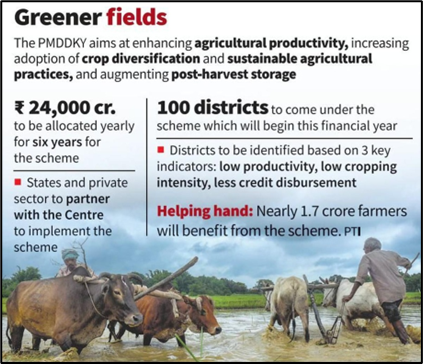Why in news?
The Union Cabinet has approved the Prime Minister Dhan-Dhaanya Krishi Yojana (PMDDKY) to develop 100 agricultural districts by integrating 36 schemes across 11 ministries.
The scheme has a yearly budget of ₹24,000 crore and will run for six years starting from 2025–26. It draws inspiration from NITI Aayog’s Aspirational District Programme and is first of its kind focusing exclusively on agriculture and allied sectors.

What’s in Today’s Article?
- Main Goals of PM Dhan-Dhaanya Krishi Yojana
- How PM Dhan-Dhaanya Krishi Yojana Districts Will Be Selected
- Implementation of the PM Dhan-Dhaanya Krishi Yojana
- Performance Ranking System for PM Dhan-Dhaanya Krishi Yojana Districts
Main Goals of PM Dhan-Dhaanya Krishi Yojana
- PMDDKY was announced in the Union Budget 2025. It focuses on improving farming in 100 districts that currently have low agricultural productivity, moderate crop intensity, and below-average credit access.
- The scheme has five main goals:
- Increase agricultural productivity.
- Promote crop diversification and sustainable farming practices.
- Expand post-harvest storage facilities at panchayat and block levels.
- Improve irrigation systems.
- Ensure easy access to both long-term and short-term credit for farmers.
- By focusing on these areas, the government aims to boost productivity, support local livelihoods, and make the country more self-reliant in agriculture.
- As these 100 districts show improvement, India’s overall farming performance is expected to rise as well.
How PM Dhan-Dhaanya Krishi Yojana Districts Will Be Selected
- Under PMDDKY, 100 districts will be chosen based on three main factors:
- Low agricultural productivity
- Moderate crop intensity
- Below-average credit availability for farmers
- Cropping intensity measures how many crops are grown on the same land in a year. At the national level, it was 155% in 2021–22, but this varies from state to state.
- The number of districts selected from each state or Union Territory will depend on its share of net cropped area and the number of farming households.
- However, every state will have at least one district included in the scheme.
Implementation of the PM Dhan-Dhaanya Krishi Yojana
- For the PMDDKY scheme, each of the 100 selected districts will get a master plan covering agriculture and related activities.
- This District Agriculture and Allied Activities Plan will be prepared by a District Dhan Dhaanya Samiti, led by the Collector and including progressive farmers as members.
- The district plans will focus on key national goals like crop diversification, saving water, protecting soil health, becoming self-sufficient in farming, and promoting natural and organic agriculture.
- Plans will be based on local farming patterns and climate conditions, created after wide consultations.
- Committees will work at district, state, and national levels to ensure smooth implementation.
- Central Nodal Officers (CNOs) will be appointed to visit the districts, monitor progress, and conduct reviews.
- Agriculture universities from both central and state levels will help each district as knowledge partners, providing expert guidance.
Performance Ranking System for PM Dhan-Dhaanya Krishi Yojana Districts
- PMDDKY will follow a model similar to the Aspirational Districts Programme (ADP) launched in 2018.
- It focuses on convergence of government schemes, collaboration between officers and districts, and healthy competition through performance rankings.
- Under PMDDKY, all selected districts will be ranked monthly based on progress across 117 Key Performance Indicators (KPIs).
- These indicators will cover areas such as agriculture, water resources, financial inclusion, infrastructure, and skill development.
- NITI Aayog will guide and support the programme by offering expertise and helping build capacity at different levels.
- A dedicated portal or dashboard will be created to track and display the progress of each district regularly.









